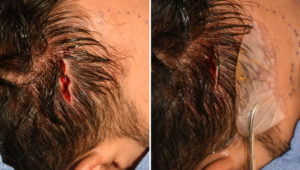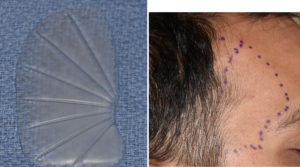The permanent treatment for temporal hollowing is a solid soft muscle implant that lies under the temporalis fascia. Such temporal implants currently exist in two styles based on the zone of temporal augmentation needed. The orbital temporal implant (style 1) fills in the typical location of temporal hollowing done at the level lateral to that of the eye. Extended temporal implants (style 2) fill the entire temporal region from just above the zygomatic arch up to the anterior temporal line of the forehead.

Extended Temporal Implant Placement technique Dr Barry Eppley IndianapolisOne of the keys in placing extended temporal implants is that it can be folded for insertion through the incision. This will allow it to easily make it though the skin incision. However it becomes very important to ensure that it lays properly in the pocket with all edges unraveled and in the correct orientation. Thus requires moving the implant partially in and out of the incision and using instruments underneath it to ensure that all edges of the implant are completely unfolded and laying flat. This also requires the the subfascial pocket be made bigger than the implant which is to occupy it. The attached video demonstrates how the extended temporal implant needs to be placed to ensure that its proper placement occurs.
The extended temporal implant, while originally a style made for a select few patients, has now become the more standard implant use for permanent temporal augmentation in my practice. This is because it covers a larger surface area which more appropriately covers the extent of temporal hollowing that many patients have.
Dr. Barry Eppley
Indianapolis, Indiana



